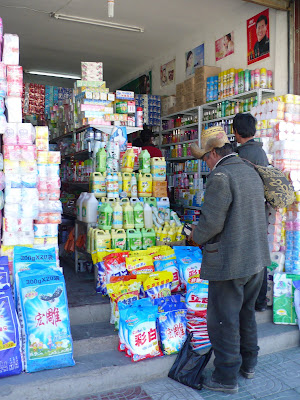
Tibet may be the most evocative place in the world. As a lodestone for spiritual seekers and daredevil explorers from the West, a David vs. Goliath political battle that has captured the world's imagination, the center of a 2,000 year old religious and philosophical tradition at the heart of Eastern thought, or simply as the impossibly remote roof of the world, Tibet exerts a powerful pull on the imagination.

As we made our winter crossing from Kathmandu to Lhasa, and then on into China, we often found ourselves tempted by various idealized visions of the world's highest Kingdom. The sheer scale of the frozen landscape, the warmth of its inhabitants, the splendor of its religion and culture, and the stark reality of the Chinese occupation pulled us in different emotional directions.

After an incredible three day journey from the lowlands of India to the Nepali capital of Kathmandu, we plotted the next phase of our journey. Unfortunately we discovered that in order to obtain a Chinese visa allowing travel to Tibet from Nepal, we would have to join a Chinese government tour (the fox now gives tours of the hen house). Not knowing what to expect, we set off across the Himalayas as part of an international ensemble of forty suitcase-schlepping tourists. Despite our fears, our companions quickly became the highlight of our journey--especially our South American compadres, Macarena and Marcelo.

From Kathmandu, we travelled through verdant hill country to the "Friendship Bridge" to China, where a walk across a deep gorge and a little paperwork deposited us in the People's Republic. At the border, we joined a jeep convoy and embarked on a four day drive up the "Friendship Highway" to Lhasa. The journey took us over some of the highest terrain in the world, with views of Everest and its towering neighbors.

Along the way, we visited a number of important Buddhist monasteries. Wandering the courtyards, corridors and clifftop aeries of the monasteries and spending time with the irrepressibly cheerful monks within may have been the highlight of our trip to date.




Even before we reached Lhasa, however, the heavy hand of the Chinese occupation was clearly in evidence. The ruins of villages levelled during the cultural revolution lined the "Friendship Highway," next to newer centrally-planned settlements flying the Chinese flag from every rooftop. In the larger towns, the traditional Tibetan buildings and streets formed outlying ghettos at the edge of grid-patterned Chinese avenues flanked by concrete and glass structures, housing businesses run by Han Chinese settlers. Every Tibetan home bears a government issued number to enable them to find any dissidents easily. The Tibetans themselves, clad in the traditional dress of the nomadic yak herder or monk's saffron robes, seemed to wander their new urban world in a kind of heartbroken daze. Alcoholism is common, especially among the older generation.


In Lhasa itself, Tibet's brilliant past and troubled future were both starker still. In Tibetan Buddhism's most important monastery, secret policemen in monk's robes scan for subversive activity over their prayer books. The Potala Palace gleamed in the sunlight and the Dalai Lama's old apartments were breathtaking, but most of the building is off limits and tourists are rapidly ushered through under the watchful eye of soldiers and surveillance cameras. Though the Dalai Lama's golden throne sits empty, a steady stream of Tibetan pilgrims still comes to pay their respects, and toss blessed prayer scarves over the fence.


At the Jokhang, Lhasa's central holy place, an unceasing tide of pilgrims from across Tibet and western China gathers to circumambulate the monastery and prostrate outside. Some prostrate themselves all the way from their homes, making their way along the highways a body-length at a time in a journey that frequently takes three to four years. We joined the crowd on a festival day, and as always were taken in by the Tibetans' warmth and friendliness. We sampled the local moonshine, and managed to glimpse some traditional music and dancing before the Chinese police inevitably broke up the gathering.



We left Tibet on the new Chinese railway, a beautiful 36-hour trip to Xi'an across the eastern half of the Tibetan plateau. Though the beauty was marred somewhat by the loudspeaker in our car incessantly proclaiming the marvel and majesty of the benevolent People's Republic, the yak herds outside the window didn't seem to mind.



1 comment:
AS THE BREEN CLAN GATHERS AT BRAE ROAD TOMORROW, WE ALL WILL MISS YOUR BEING THERE... BUT IT'S WONDERFUL KNOWING THAT YOU ARE TOGETHER AND SO HAPPY!!! HAVE A MERRY CHRISTMAS AND A HEALTHY NEW YEAR!
LOVE,
LINDA
Post a Comment